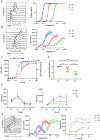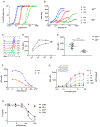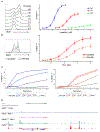Activation of the Tec Kinase ITK Controls Graded IRF4 Expression in Response to Variations in TCR Signal Strength
- PMID: 32493815
- PMCID: PMC7343623
- DOI: 10.4049/jimmunol.1900853
Activation of the Tec Kinase ITK Controls Graded IRF4 Expression in Response to Variations in TCR Signal Strength
Abstract
TCR signal strength is critical for CD8+ T cell clonal expansion after Ag stimulation. Levels of the transcription factor IRF4 control the magnitude of this process through the induction of genes involved in proliferation and glycolytic metabolism. The signaling mechanism connecting graded TCR signaling to the generation of varying amounts of IRF4 is not well understood. In this study, we show that Ag potency regulates the kinetics but not the magnitude of NFAT1 activation in single mouse CD8+ T cells. Consequently, T cells that transduce weaker TCR signals exhibit a marked delay in Irf4 mRNA induction, resulting in decreased overall IRF4 expression in individual cells and increased heterogeneity within the clonal population. We further show that the activity of the tyrosine kinase ITK acts as a signaling catalyst that accelerates the rate of the cellular response to TCR stimulation, controlling the time to onset of Irf4 gene transcription. These findings provide insight into the function of ITK in TCR signal transduction that ultimately regulates IRF4 expression levels in response to variations in TCR signal strength.
Copyright © 2020 by The American Association of Immunologists, Inc.
Figures





References
-
- Andreotti AH, Joseph RE, Conley JM, Iwasa J, and Berg LJ. 2018. Multidomain Control Over TEC Kinase Activation State Tunes the T Cell Response. Annu. Rev. Immunol 36: 549–578. - PubMed
Publication types
MeSH terms
Substances
Grants and funding
LinkOut - more resources
Full Text Sources
Molecular Biology Databases
Research Materials

